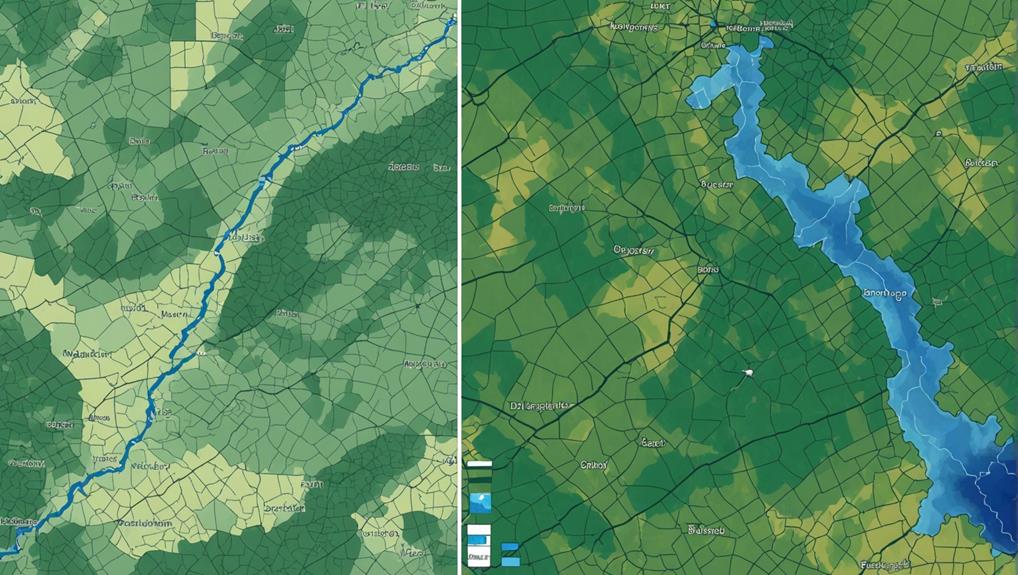The bustling town of Aylesbury is bracing itself for significant travel disruptions as a crucial thoroughfare into the town is […]
To navigate Buckinghamshire's average rainfall of 725mm, you'll need to understand the seasonal patterns, with winter months being slightly wetter than summer months, and September and October being the wettest. Analyze long-term historical data to identify trends and correlations between rainfall and climate factors. Finally, identify regional precipitation trends by comparing historical data and seeking reliable sources like the Met Office. By grasping these factors, you'll better prepare for the region's precipitation patterns. As you explore further, you'll uncover more insights into Buckinghamshire's climate dynamics, helping you make informed decisions.
Key Takeaways
• Buckinghamshire's average annual rainfall is 725mm, with winter months being slightly wetter than summer months.
• September and October are the wettest months, making them crucial for agricultural planning and climate change impact assessments.
• Analyzing historical data and regional precipitation trends helps identify correlations between rainfall and climate factors, enhancing understanding of Buckinghamshire's climate.
• Geographic factors like elevation and proximity to the coast influence local rainfall patterns, making regional climate averages and trends essential for understanding rainfall distribution.
• Understanding seasonal rainfall patterns is crucial for agricultural planning, and recognizing shifts in these patterns can indicate climate change effects.
Understanding Seasonal Rainfall Patterns
As you explore Buckinghamshire's rainfall, you'll notice that the county's seasonal patterns are characterized by a subtle yet significant shift in precipitation levels throughout the year. While the average annual rainfall of 725mm might seem essential, there's a notable rainfall variability between seasons.
Winter months tend to be slightly wetter, whereas summer months receive the least amount of rainfall. Surprisingly, September and October are the wettest months, accounting for a substantial portion of the yearly rainfall.
Understanding these seasonal rainfall patterns is vital for agricultural planning and water resource management in Buckinghamshire. Climate change impacts are also becoming increasingly relevant, as they can exacerbate rainfall variability and alter the traditional seasonal patterns.
Analyzing Long-term Historical Data
By delving into long-term historical data, you can uncover the intricacies of Buckinghamshire's average rainfall patterns, revealing valuable insights into the county's climate dynamics. Examining annual precipitation data from reputable sources like the Met Office provides a thorough understanding of the region's rainfall trends.
You can access detailed climate analysis datasets at the Centre for Environmental Data Analysis (CEDA), which hosts the Met Office's MIDAS datasets. These datasets offer extensive coverage of weather data, making them invaluable for climate researchers.
When evaluating historical trends, you'll notice patterns and anomalies that can inform your understanding of Buckinghamshire's rainfall. By analyzing the data, you'll identify correlations between rainfall and other climate factors, such as temperature and atmospheric pressure. This in-depth analysis enables you to better comprehend the intricacies of the county's climate, ultimately helping you navigate Buckinghamshire's average rainfall with confidence.
Identifying Regional Precipitation Trends

You'll find that analyzing regional precipitation trends in Buckinghamshire reveals a more nuanced understanding of the county's rainfall patterns, allowing you to pinpoint areas of significant change.
By examining long-term trends in precipitation, you'll gain insight into the regional climate and its influence on rainfall distribution. Consider the impact of geographic factors, such as elevation and proximity to the coast, on local rainfall patterns.
For a more accurate picture, compare historical rainfall data in Buckinghamshire to identify any significant shifts or anomalies that may indicate climate change effects.
Utilize regional climate averages and trends from reliable sources like the Met Office to assess the overall precipitation patterns in Buckinghamshire over time. This will help you understand how the regional climate is changing and how it affects rainfall distribution.
Frequently Asked Questions
What Is the Average Rainfall in Buckinghamshire?
Understanding these patterns is crucial in order to mitigate potential risks and plan effectively in Buckinghamshire, which receives around 600-700 mm of rainfall annually, leading to flooding impacts, especially during weather extremes.
What Is the Average Rainfall Like in the Uk?
You're likely aware that the UK's average annual rainfall is around 1,154mm, influenced by climate change and weather forecasting challenges, making it important to monitor and adapt to these changes for effective resource management.
What Is the Pattern of Rainfall in the Uk?
You'll notice the UK's rainfall pattern is influenced by Atlantic weather fronts, bringing most rain to western regions, with climate change impacting patterns, making wet seasons wetter and dry seasons drier, altering the usual October-November peak.
Which County Has the Most Rainfall in the Uk?
You're probably wondering which county gets the most rainfall in the UK. Well, it's not the Scottish Highlands, but Cumbria takes the top spot, receiving a whopping 2,000mm of rainfall annually, making it the wettest county in the UK.
Conclusion
You've made it to the end of this rainfall navigation guide!
By understanding seasonal rainfall patterns, analyzing long-term historical data, and identifying regional precipitation trends, you're now better equipped to tackle Buckinghamshire's average rainfall.
Remember, knowledge is power, especially when it comes to staying dry in this rainy region. Stay informed, stay prepared, and you'll be dancing in the rain – or at least, not getting too wet.